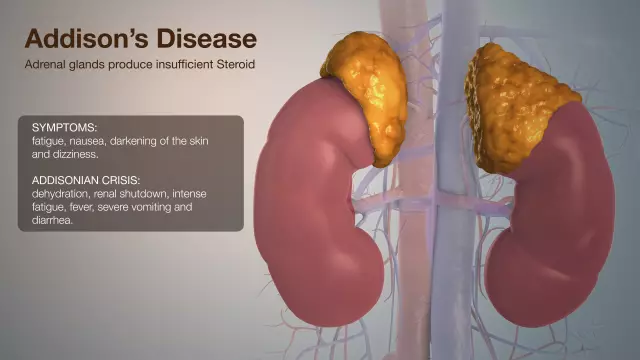- Author Rachel Wainwright [email protected].
- Public 2023-12-15 07:39.
- Last modified 2025-11-02 20:14.
Von von Willebrand disease
The content of the article:
- Causes and risk factors
- Forms of the disease
- Symptoms
- Features of the course of the disease during pregnancy
- Diagnostics
- Treatment
- Possible complications and consequences
- Forecast
- Prevention
Von Willebrand disease is a pathology of the blood coagulation system caused by impaired synthesis or qualitative changes in the coagulation factor of the same name.

Spontaneous prolonged nosebleeds may indicate von Willebrand disease
Von Willebrand factor (vWF) is present in the blood in combination with coagulation factor VIII, performing the following functions:
- ensuring adequate adhesion of platelets to the vascular wall in case of bleeding;
- stabilization due to complexation and transportation to the place of formation of a platelet clot in case of violation of the integrity of the vessel VIII coagulation factor.
The disease was first described by Eric von Willebrand in 1926 (established in the natives of the Aland Islands). Examining a 5-year-old patient, he drew attention to the fact that out of 12 children in the family, 4 died at an early age from various bleeding, both parents also suffered from episodes of spontaneous bleeding. Upon further investigation, it was revealed that 23 relatives of 66 members of this family were also susceptible to increased bleeding. Willebrand identified the open disease as a new type of coagulopathy - "pseudohemophilia".
The named pathology is the most common hemorrhagic diathesis: it is found in about 1% of the population.
About 2/3 of patients suffer from a mild disease, most of them have no symptoms. Approximately 30% suffer from severe to moderate forms. Von Willebrand disease is more common in childhood and in women of childbearing age.
Causes and risk factors
The disease is inherited in an autosomal recessive or autosomal dominant pattern. The probability of transmission of the disease from mother to child is 50%, but only in 1/3 of cases there are clinically significant manifestations of the disease.
The main cause of the pathology is a violation of the gene encoding the von Willebrand factor, which is located on the short arm of the 12th chromosome.

In von Willebrand disease, the mechanisms of blood clot formation are disrupted
As a result of mutation, a number of changes occur:
- absence of large multimers of von Willebrand factor;
- increased affinity (bond strength, affinity) of a factor for the platelet receptor GB-Ib in combination with the absence of large multimers;
- a decrease in the affinity of von Willebrand factor for the platelet receptor GP-Ib without disturbing the multimeric structure;
- decrease in the affinity of von Willebrand factor for factor VIII, etc.
Based on the variants of functional defects, the corresponding types of disease are distinguished.
Forms of the disease
According to the recommendations of the Scientific and Standardization Committee (SSC) of the International Society for Thrombosis and Hemostasis, von Willebrand disease is classified as follows:
- Type I - a decrease in the synthesis of von Willebrand factor and the antigen associated with it. In type I blood plasma, all multimers of the factor are present. Occurs in 55-75% of cases;
- Type II - a sharp decrease in the formation and content of the most active large multimers of the von Willebrand factor in the blood, the predominance of small multimers with low hemostatic activity;
- Type III - almost complete absence of von Willebrand factor, is extremely rare (in 1-3% of cases).
Depending on the characteristics of the phenotype, type II of the disease is divided into several subtypes:
- IIA - qualitative factor defects with a decrease in vWF-dependent platelet adhesion and an isolated deficiency of high molecular weight multimers;
- IIB - qualitative defects of von Willebrand factor with an increased affinity for the GP-Ib receptor of platelets;
- IIN - impaired ability of von Willebrand factor to bind to coagulation factor VIII;
- IIM - the presence of vWF defects in the absence of a deficit of multimers.
Several factors affect the level of von Willebrand factor in the blood:
- age (the level increases as they grow older);
- floor;
- ethnicity (the level is higher in Africans and African Americans);
- blood group (the half-life of the factor in individuals with blood group I is approximately 1/4 less than in carriers of other groups);
- hormonal background (decreased in hypothyroidism, increases during pregnancy).
Symptoms
The symptomatology of the disease is extremely diverse: from minor episodic bleeding to massive, exhausting, leading to severe blood loss.
More often, increased bleeding is noted in childhood, decreasing as they grow older, and then there is an alternation of exacerbations and remissions.

Subcutaneous hematomas that appear spontaneously - a symptom of von Willebrand disease
Signs characteristic of von Willebrand disease:
- bleeding for more than 15 minutes after minor injuries or spontaneously recurrent bleeding 7 days or more after injury;
- severe, prolonged or spontaneously recurring bleeding after minor surgery, tooth extraction;
- subcutaneous hematomas that appear after minor traumatic effects or spontaneously;
- hemorrhagic skin rash;
- spontaneous nosebleeds lasting more than 10 minutes or requiring due to the intensity of medical intervention;
- blood in the stool in the absence of gastrointestinal pathology that can provoke the development of gastrointestinal bleeding;
- severe anemia;
- intense, prolonged menstruation.

Women with von Willebrand disease have long, intense periods.
Features of the course of the disease during pregnancy
Pregnancy has a mixed impact on the course of von Willebrand disease. Often, when pregnancy occurs under the influence of estrogens, the von Willebrand factor level in blood plasma rises, the same tendency can be observed before childbirth. However, these changes do not occur in all women.
According to research results, there is a high frequency of spontaneous abortion in the early stages - 22-25% in women suffering from this pathology. Approximately 1/3 of women have bleeding in the first trimester of pregnancy.
Most women with von Willebrand disease type I reach normal (for non-pregnant) factor levels in the last trimester of pregnancy. In type II disease, levels of factor VIII and von Willebrand factor often increase during pregnancy, but most studies have shown minimal or no change in the level of clotting factor activity and persistence of the pathological structure of multimers. In women with type III von Willebrand disease, levels of factor VIII and von Willebrand factor do not increase significantly during pregnancy.

Women with von Willebrand disease have a high risk of spontaneous early abortion
Women with von Willebrand disease are at increased risk of primary (more than 500 ml on the first day after delivery) and secondary postpartum hemorrhage (24 hours to 6 weeks) due to the rapid decline in clotting factor activity after childbirth.
Diagnostics
The diagnosis is based on the indicators of the hemostasis system:
- prolonged bleeding time (with type I, in some patients the indicator is within normal limits);
- activated partial thromboplastin time (APTT) (normal or prolonged);
- a significant change in the parameters of ristocetin-induced platelet aggregation;
- changes in the level of von Willebrand factor in blood plasma and the balance of its multimers depending on the type of disease;
- change in the level of von Willebrand factor antigen in the blood;
- normal blood clotting time (with the exception of type III disease).
General and biochemical blood tests do not show characteristic changes, in rare cases, there is a low iron content, up to anemia.

To diagnose von Willebrand disease, it is necessary to know the level and activity of von Willebrand factor (vWF) in the patient's blood
In addition to the study of hemostasis, instrumental methods of examination of patients are shown (EGD, ultrasound of the abdominal cavity organs, MRI) in order to exclude hidden bleeding.
Treatment
The goal of treatment is to increase the concentration or replace the missing coagulation factors. Treatment can be prophylactic or on demand for acute bleeding.
Therapy for von Willebrand disease is carried out in three ways (depending on the severity of the condition):
- The use of drugs that increase the level of intrinsic von Willebrand factor.
- Substitution therapy with blood preparations containing von Willebrand factor.
- Local therapy of damage to the mucous membranes and skin.

Von Willebrand disease is an indication for the use of blood products containing vWF
The main groups of drugs used in treatment:
- hormonal agents;
- antifibrinolytic drugs;
- local hemostatics;
- plasma concentrates.
Possible complications and consequences
The main complication of von Willebrand disease is the development of bleeding (including intra-articular, intracavitary and bleeding into the structures of the brain), which can lead to fatal consequences.
Forecast
With timely diagnosis and complex therapy, the prognosis is favorable.
Prevention
Since the disease is genetic, it is not possible to prevent its development, but there are a number of measures that can significantly reduce the risk of bleeding:
- refusal to take non-steroidal anti-inflammatory drugs;
- exclusion of antiplatelet agents (acetylsalicylic acid, clopidogrel);
- regular preventive examinations;
- prevention of traumatic influences.
YouTube video related to the article:

Olesya Smolnyakova Therapy, clinical pharmacology and pharmacotherapy About the author
Education: higher, 2004 (GOU VPO "Kursk State Medical University"), specialty "General Medicine", qualification "Doctor". 2008-2012 - Postgraduate student of the Department of Clinical Pharmacology, KSMU, Candidate of Medical Sciences (2013, specialty "Pharmacology, Clinical Pharmacology"). 2014-2015 - professional retraining, specialty "Management in education", FSBEI HPE "KSU".
The information is generalized and provided for informational purposes only. At the first sign of illness, see your doctor. Self-medication is hazardous to health!






